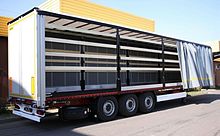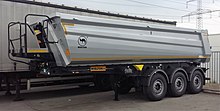Semi-trailers
Semi-trailer (including semi-trailers or short trailers and English Semitrailer or only trailer called) are trailers that part of their weight between the axles of a tractor relocate with which they have a saddle plate together with kingpin to be connected. Semi-trailers are mostly multi-axle and this is how they differ from single-axle trailers .
history
Semi-trailers have their origins in the USA, although the blacksmith Emil Jagenberg invented the first trailer for use on motorized commercial vehicles in Germany as early as 1903 . In 1914, the carriage builder August Fruehauf constructed the first semi-trailer in the USA , which was primarily intended for the transport of tree trunks. As early as 1918, he expanded his product range for the transport of other special goods, thereby laying the foundation for the Fruehauf company . As a result, various components developed by different inventors were added, which form the basis for the semi-trailers in use today.
In 1958, Kögel manufactured the "longest articulated lorry in the world" with a semi-trailer of an estimated 30 m length made of two steel girders lying next to each other, with a rope undercarriage and a steerable 2-axle dolly near the rear end, for transporting tree trunks that are less long.
application
Semi-trailers are considered non-motorized commercial vehicles and must be driven with their own license plate in traffic. In addition to their use in road haulage , they are also increasingly used in agriculture . Semi-trailers with German approval have standard internal dimensions of 13.625 m × 2.48 m × 2.70 m and maximum external dimensions of 13.68 m × 2.55 m × 4.00 m. This means that they offer less loading length than trailers , the combined length of which can be over 15 m. In North America, measurements up to 8 feet 6 inches by 53 feet are possible. However, the advantages of a semi-trailer over a trailer truck are the continuous loading area, which is not divided into two vehicles, and the easier driving and maneuvering operations. Due to the lower dead weight, the payload of a semi-trailer is usually greater than that of the trailer.
variants
There are different types of semi-trailers:
- Tarpaulin trailer (tautliner)
- Box trailers and refrigerated goods trailers
- Tipper trailer (tipper)
- Low loader trailer (mega trailer)
- Flatbed trailers
- Container trailers
- Moving floor trailer
- Silo trailers and tank trailers
- Inloader
- Vehicle transport trailers
- Passenger transport trailers
Semi-trailers with two or three axles are sometimes also referred to as tandem and trideman trailers, although this term is actually intended for trailers with central axle suspension and hitch .
Semi-trailers are also used in unaccompanied combined transport . This requires cranable semitrailers with standardized lifting points, which can be loaded onto pocket wagons with the help of gantry cranes or reach stackers . The underrun protection , which is intended to prevent lower vehicles from getting under the trailer in the event of a rear-end collision , can be folded in on semi-trailers for combined transport.
In the past in particular, there were also semitrailers for passenger transport, etc. a. as airport apron buses . See also articulated bus .
Manufacturer
Semi-trailers are mostly manufactured by medium-sized companies . In addition to series production, individual designs can also be implemented. In recent years, however, the originally strongly regionalized supplier market has changed significantly in parallel to the development of road haulage due to rapid growth, internationality and brand acquisitions.
The three largest manufacturers of semi-trailers in Europe include Schmitz Cargobull and Krone from Germany and Wielton from Poland , which together produce around 120,000 units per year. As the world's largest manufacturer of semi-trailers, there are also CIMC from China and Wabash National and Great Dane from the USA with a total of around 210,000 completed units. Other European providers include Benalu , Chèreau , Feber , Fliegl , Gniotpol , Kässbohrer , Kögel , Legras , Schwarzmüller , SDC , Stas , Tirsan , Van Hool and Zasław .
According to research by Global Trailer Magazine , the largest semi-trailer manufacturers are:
| Manufacturer | Country of origin | Annual volume |
|---|---|---|
| CIMC |
|
100,300 |
| Wabash National |
|
63,450 |
| Great Dane |
|
60,850 |
| Schmitz Cargobull |
|
50,000 |
| Hyundai Translead |
|
49,750 |
| UTM |
|
49,200 |
| Crown |
|
49,000 |
| Wielton |
|
16,500 |
| Stoughton |
|
16,000 |
| Kögel |
|
13,000 |
| Huajun |
|
10,750 |
| Randon |
|
10.100 |
| SDC |
|
9,500 |
| Tirsan |
|
9,300 |
| Schwarzmüller |
|
7,800 |
Due to different market requirements as well as legal regulations, the industry is still strongly regionalized in large parts. Of the manufacturers mentioned above and among the top 15, only Schmitz Cargobull , Krone , Wielton and Schwarzmüller play a role in Europe , while other European manufacturers usually concentrate on their home markets. With the exception of CIMC , manufacturers from overseas are in no way present in Europe, although they have a higher annual volume in terms of numbers.
See also
Web links
Trade press on topics related to semi-trailers:
Individual evidence
- ↑ Trailer: A vehicle without its own drive for the transport of goods, which is provided for coupling to a motor vehicle in such a way that a substantial part of its weight and load is borne by the motor vehicle. (Definition of the European Conference of Transport Ministers, Federal Law Gazette 2015 II pp. 69, 72 )
- ↑ History of the semi-trailers in the USA
- ↑ Patent proof for the chassis for semi-trailers
- ↑ Chronicle> 1950s reconstruction and enlargement koegel.com, 2014, accessed January 8, 2018. - "Image: 1958 - The longest articulated truck in the world at the time" (in front of a forest)
- ↑ Dimensions of the semi-trailers made by Schmitz Cargobull and Krone
- ↑ Truck in the USA with backgrounds of the lengths and sizes of semi-trailers
- ↑ Wielton - From sixth place to third place in Europe , in: Transport , edition 3/2016, vol. 26, p. 17
- ↑ The World's Top 30 - Top Trailer Builders , in: Global Trailer , edition 30/2016, vol. 3, p. 42
- ↑ The World's Top 30 - Top Trailer Builders , in: Global Trailer , edition 30/2016, vol. 3, p. 42
- ↑ Market forecast for semi-trailers until 2022









